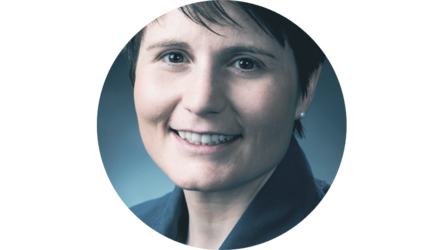Cluster overview
The mission
Cluster is a collection of four spacecraft flying in formation around the Earth, relaying the most detailed ever information about how the solar wind affects our planet in three dimensions. The solar wind (the perpetual stream of subatomic particles given out by the Sun) can damage communications satellites and power stations on the Earth. The operation lifetime of the Cluster mission runs from February 2001 and December 2005.
The four Cluster spacecraft have spent several years passing in and out of our planet's magnetic field. Their mission will be to complete the most detailed investigation yet made into the ways in which the Sun and Earth interact.
What's special
The Sun emits the solar wind - this is a thin, hot, ionized gas which carries particles and magnetic fields outward from the Sun.
The Earth is shielded from the full blast by its magnetosphere, the region around our planet controlled by its magnetic field. Some solar wind descends into Earth's upper atmosphere through the polar cusps, funnel-like openings in the magnetosphere at the poles. These energetic particles excite atoms and molecules in the upper atmosphere to create the Northern and Southern Lights (the auroras). The portion of a planetary magnetosphere which is pushed in the direction of the solar wind is known as the magnetotail.
Cluster determine the physical processes involved in the interaction between the solar wind and the magnetosphere by visiting key regions like the polar cusps and the magnetotail. The four Cluster spacecraft map in three dimensions the plasma structures contained in these regions. The simultaneous four-point measurements also allow close studies of plasma quantities in both space and time.
During periods of high solar activity (which cycles every 11 years), the solar wind can be particularly energetic and this can have a dramatic effect on human activities, disrupting electrical power and telecommunications or causing serious problems in the operation of satellites, especially those in geostationary orbit. Subtle changes to the weather on Earth occurs also during these times. Watching the effects of this increased activity during these periods is one of the main tasks of Cluster.
By understanding the interreaction between the solar wind and the magnetosphere and how the plasma levels of the magnetosphere are affected, Cluster will help us on Earth be able to prepare for the effects of sudden bursts of solar energy.
The spacecraft
The Cluster spacecraft resemble giant 'Lego' sets, assembled by hand from thousands of individual parts. Each one is shaped like a giant disc, 1.3 m high and 2.9 m across and in the centre is a cylinder.
Six spherical fuel tanks are attached to the outside of this central cylinder. The fuel they carry accounts for more than half the launch weight of each spacecraft with most of the fuel being consumed soon after launch, during the complex manoeuvres required to reach their operational orbits. Each spacecraft also carries eight thrusters for smaller changes of orbit.
Around the central cylinder is the main equipment platform. Electrical power is provided by six curved solar panels attached around the outside of the platform and five batteries are used for power supply during the four-hour-long eclipses when the spacecraft enter Earth's shadow.
Various rod-shaped booms open out once the satellite reaches orbit - two antennae for communications, two sensors and four wire booms which operate when the spacecraft begins to spin. These measure changing electrical and magnetic fields around each spacecraft.
The journey
At each launch two Cluster satellites were placed in an elliptical orbit whose height varied from 200 km to 18 000 km above the Earth. The two satellites of each launch were then released, one after the other and used their own on-board propulsion systems to reach the final operational orbit (between 19 000 and 119 000 kilometres from the planet).
The first pair of Cluster satellites lifted off on 16 July 2000, and were followed by the second pair one month later. This gap allowed fewer people to be used for mission control in the European Space Operations Centre (ESOC) in Darmstadt (Germany).
Once the booster reached the correct altitude, eight minutes 48 seconds after liftoff, the Fregat payload assist module and its two Cluster spacecraft were released. The Fregat main engine fired almost immediately to achieve a circular orbit of approximately 200 kilometres altitude. About one hour later, the Fregat engine fired again to inject the spacecraft into an elliptical orbit.
The two satellites were released, one after the other. Each Cluster spacecraft main engine performed six major manoeuvres. These orbital changes were made possible by the large amount of on-board fuel, which made up approximately half of each satellite's launch mass.
The history
The Cluster mission was first proposed in November 1982 in response to an ESA Call for Proposals for the next series of science missions. The idea was developed into a proposal to study the `cusp' and the ‘magnetotail’ regions of the Earth's magnetosphere with a polar orbiting mission. The Cluster idea developed into a proposal and then a mission. In 1996, Cluster was ready to be launched. Cluster was expected to benefit from a `free' launch on the first test flight of the newly developed Ariane-5 booster. After several minor delays, Ariane-501 lifted off from Kourou, French Guiana on 4 June 1996, carrying its payload of four Cluster satellites. Unfortunately, the launcher's maiden flight lasted just 37 seconds before intense aerodynamic loads resulted in its break up and initiation of the automatic destruct system. Debris from the Cluster spacecraft was scattered across the mangrove swamps near the launch site. It seemed to all concerned that 10 years of work had come to nothing. However, in July 1996, after considering possible ways of recovering at least some of the unique science from the mission, ESA decided to build a fifth Cluster satellite. Appropriately named `Phoenix', after a mythical Arabian bird that was burnt on a funeral pyre and then was reborn by rising from the ashes, this spacecraft was to be identical to the original Cluster spacecraft. It would be equipped with flight spares of the experiments and subsystems prepared for the Cluster mission. New equipment would only be manufactured when necessary. By taking advantage of the existing hardware, together with the knowledge and experience gained in the original programme, Phoenix was expected to be fully integrated and tested by mid-1997, opening the way for a launch later that year. This rapid response to the launch failure soon gave way to a longer term strategy. An awareness that the scientific objectives of the Cluster mission could not be met by a single spacecraft led to proposals to rebuild three or four full-size Cluster spacecraft alongside Phoenix. Although these proposals had significant implications for an ESA science budget that was already fully committed, it was accepted that the costs of a full rebuilding programme would be much lower, since the spacecraft had already been through a complete cycle of design, development and testing. The aim was for completion so that they would be available to study the Sun during the peak of the solar cycle, which was expected in the year 2000. Since the Ariane-5 was now considered too expensive for the project, alternatives had to be found. A new company called Starsem was starting to commercialise the Soyuz rocket and made an offer that could fit under the very stringent cost cap. After a preliminary study, it was clear that a Soyuz rocket could lift-off a pair of spacecraft. However the very eccentric orbit required a new upper stage to be developed. From the previous experience, ESA requested two test flights to qualify the upper stage before the Cluster launches. These two flights were successfully conducted at the beginning of 2000 and about 6 months later, Cluster was launched by a Soyuz-Fregat launcher from Baikonur Cosmodrome, Kazakhstan.
Partnerships
Prime contractor for the original (destroyed) Cluster and replacement Cluster satellites was Dornier Satellitensysteme GmbH (now Astrium), Friedrichshafen, Germany, the leader of an industrial consortium involving 35 major contractors from all of the ESA member countries and the United States. The Cluster project was managed by the ESA Cluster Project team under the direction of the Project Manager.
Each spacecraft carries an identical set of 11 instruments to investigate charged particles, electrical and magnetic fields. These were built by European and American instrument teams led by Principal Investigators.
The Cluster scientific community includes the ESA Project Scientist, 11 Principal Investigators and more than 250 Co-Investigators from ESA member states, the United States, Canada, China, the Czech Republic, Hungary, India, Israel, Japan and Russia.















 Germany
Germany
 Austria
Austria
 Belgium
Belgium
 Denmark
Denmark
 Spain
Spain
 Estonia
Estonia
 Finland
Finland
 France
France
 Greece
Greece
 Hungary
Hungary
 Ireland
Ireland
 Italy
Italy
 Luxembourg
Luxembourg
 Norway
Norway
 The Netherlands
The Netherlands
 Poland
Poland
 Portugal
Portugal
 Czechia
Czechia
 Romania
Romania
 United Kingdom
United Kingdom
 Slovenia
Slovenia
 Sweden
Sweden
 Switzerland
Switzerland

























